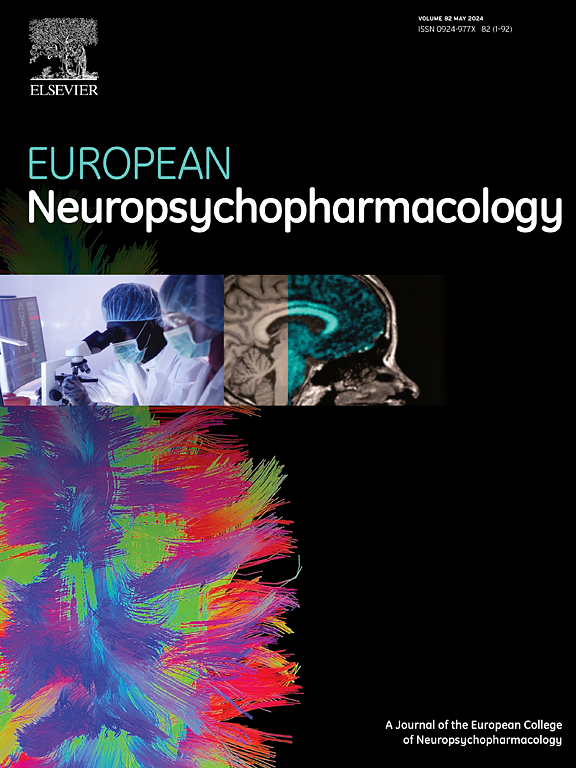Longitudinal brain age in first-episode mania youth treated with lithium or quetiapine
IF 6.1
2区 医学
Q1 CLINICAL NEUROLOGY
引用次数: 0
Abstract
It is unclear if lithium and quetiapine have neuroprotective effects, especially in early stages of bipolar and schizoaffective disorders. Here, an age-related multivariate brain structural measure (i.e., brain-PAD) at baseline and changes in response to treatment after a first-episode mania (FEM) were examined. FEM participants were randomized to lithium (n=21) or quetiapine (n=18) monotherapy. T1-weighted scans were acquired at baseline, 3-months (FEM participants only) and 12-months. Brain age predictions for healthy controls (n=29) and young people with bipolar or schizoaffective disorder (15–25 years) were derived using a deep learning model trained on one of the largest datasets (N=53,542) to date. Notably, a higher brain-PAD value (predicted brain age - age) signifies an older-appearing brain. Baseline brain-PAD was higher in young people with FEM compared to controls (+1.70 year, p=0.04; Cohen's d=0.53 [SE=0.25], CI 95% [0.04 to 1.01]). However, no significant effects of time or treatment group, nor an interaction between the two, were observed throughout the course of the study. Baseline brain-PAD did not predict any change in symptomatic, quality of life or functional outcome scores over 12 months. In young individuals with FEM, baseline findings show their brains appeared older than controls. However, brain-PAD remained stable over time across treatment groups and neither baseline values nor treatment predicted 12-month outcomes. A longer follow-up with a larger sample is warranted to determine if treatment effects emerge later in bipolar and schizoaffective disorders.
Trial registration
Australian and New Zealand Clinical Trials Registry – ACTRN12607000639426.
锂或喹硫平治疗首发躁狂青年的纵向脑年龄
目前尚不清楚锂和喹硫平是否具有神经保护作用,特别是在双相情感障碍和分裂情感障碍的早期阶段。在这里,年龄相关的多变量脑结构测量(即脑pad)在基线和第一发作躁狂(FEM)后治疗反应的变化进行了检查。FEM参与者随机接受锂(n=21)或喹硫平(n=18)单药治疗。在基线、3个月(仅限FEM参与者)和12个月时进行t1加权扫描。健康对照(n=29)和患有双相情感障碍或分裂情感障碍的年轻人(15-25岁)的脑年龄预测是使用迄今为止最大的数据集之一(n= 53,542)训练的深度学习模型得出的。值得注意的是,较高的脑- pad值(预测的脑年龄-年龄)意味着一个看起来更老的大脑。与对照组相比,年轻FEM患者的基线脑- pad更高(+1.70年,p=0.04;科恩的d = 0.53 SE = 0.25, 95% CI[0.04 - 1.01])。然而,在整个研究过程中,没有观察到时间或治疗组的显著影响,也没有观察到两者之间的相互作用。在12个月的时间里,脑外pad基线不能预测症状、生活质量或功能结局评分的任何变化。在患有FEM的年轻人中,基线结果显示他们的大脑比对照组更老。然而,随着时间的推移,脑外pad在治疗组中保持稳定,基线值和治疗都不能预测12个月的结果。更长的随访和更大的样本是必要的,以确定治疗效果是否出现在双相情感障碍和分裂情感障碍。试验注册澳大利亚和新西兰临床试验注册- ACTRN12607000639426。
本文章由计算机程序翻译,如有差异,请以英文原文为准。
求助全文
约1分钟内获得全文
求助全文
来源期刊

European Neuropsychopharmacology
医学-精神病学
CiteScore
10.30
自引率
5.40%
发文量
730
审稿时长
41 days
期刊介绍:
European Neuropsychopharmacology is the official publication of the European College of Neuropsychopharmacology (ECNP). In accordance with the mission of the College, the journal focuses on clinical and basic science contributions that advance our understanding of brain function and human behaviour and enable translation into improved treatments and enhanced public health impact in psychiatry. Recent years have been characterized by exciting advances in basic knowledge and available experimental techniques in neuroscience and genomics. However, clinical translation of these findings has not been as rapid. The journal aims to narrow this gap by promoting findings that are expected to have a major impact on both our understanding of the biological bases of mental disorders and the development and improvement of treatments, ideally paving the way for prevention and recovery.
 求助内容:
求助内容: 应助结果提醒方式:
应助结果提醒方式:


